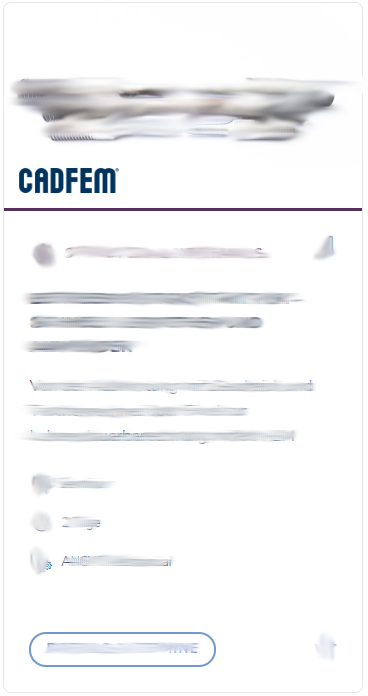
Simulation of Optical Systems with Ansys Speos
Simulation in the visible, UV and infrared range

From optical sensors to lighting solutions. In this training, you will learn to use the precision of Speos for your simulations. This training is offered as a 2-day course or alternatively as a self-paced eLearning course.
Duration
2 days
Software used
Ansys Speos
- Understanding of modeling and evaluation of lighting systems
- Practical exercises in photometry and colorimetry
- Systematic inclusion of individual components in the simulation
- Efficient design of the workflow in the development process
Description
Light is omnipresent as the basis of our perception of reality. It is therefore extremely important to understand and control the propagation, distribution, and composition of light. Within the framework of an optical simulation, such questions can be analyzed based on quantifiable characteristic quantities. With physics-based descriptions of the sources and material properties and a suitable environment for geometry preparation, the design, layout and validation of optical systems are possible with the highest level of accuracy.
Starting from basic application examples, you will learn the most important aspects of light description. In selected practical exercises, you will learn how to model and analyze optical systems using Ansys Speos. This will help you to understand how optical systems can be systematically developed and evaluated.
This training is aimed at anyone interested in understanding how to evaluate the optical properties of a system and how to model human visual perception. In addition, designers of lights, lightguides and displays, who want to improve the brightness and homogeneity of the light distribution of their products, will have their needs addressed.
Get a first impression and test the first eLearning module of this training course without any obligation. No costs, no notice period.
Detailed agenda for this 2-day training
Day 1
01 Introduction to optical simulation in Speos
- CAD import und CAD connection
- User interface
- Material properties, sources, sensors, simulations
- Workshop: Simple headlamp model
02 Geometric environment of Speos
- First steps in the geometric environment
- Sketch-based geometry setup
- Basic functionalities for geometries
- Workshop: Building up a geometric model in Speos
03 Light distribution and brightness
- Application areas for optical simulation
- Wave optics and raytracing
- Fundamental quantities and sensors of photometry
- LED as a basic light source
- Workshop: Light distribution of a ceiling lamp
04 Color evaluation and ambient light
- Use of light beyond lighting
- Light spectrum and colorimetry
- Simulation concepts in Speos: Live Preview and inverse Simulation
- Workshop: Optical simulation of an electronic user interface
Day 2
05 Interaction of light and matter
- Optical material properties
- Surface optical material models
- BRDF, BSDF and surface roughness
- Material modeling in the optical lab
- Workshop: Validation of material models
06 Basic optical components
- Examples of industrial lighting applications
- Challenges in the design of optical components
- Total Internal Reflection
- Workshop: Parametric study of a lightguide
07 Luminance simulation and visualization
- Luminance as main quantity for visualization
- Physics-based visualization
- Modeling of human visual perception
- Workshop: Simulation-based visualization of a light guide
08 Advanced topics in optical simulation
- Multiphysics: optics and mechanics
- Handling of simulation parameters
- Scripting and automation
- Workshop: Optical simulation of a deformed lens
Your Trainers

Dr. rer. nat. Ervand Kandelaki

Mohamed Jegham

Dr.-Ing. Damien Cabut
Placement in the CADFEM Learning Pathway
Participant data
Additional information
Commentary
Get a first impression and test the first eLearning module of this training course without any obligation. No costs, no notice period.
Whether eLearning, classroom courses, live online training or customized workshops - together we identify the best option for you.
Do you have questions on the training or the eLearning?
If you book through your university, you will receive a 50% discount on the stated fee on training courses and eLearning courses.
For more information on the validity and how booking with the code ACADEMIC50 works, please visit our page on training for academic users.
Straight after you sign up, an automatic confirmation of receipt will be sent to the email addresses you provided. Once you have successfully verified the data you provided, you will receive your personalized sign-up confirmation, containing further information on course fees, the billing address, etc., by email within two to three working days.
As soon as the minimum number of attendees has been reached, you will receive a final training confirmation containing further information. If you have booked an on-site training, we recommend that you wait until you have received this final confirmation before booking your travel and accommodation.
If the minimum number of attendees is not reached, we reserve the right to cancel the training seven days before it is due to start at the latest. We are happy to inform you on changing your booking to an alternative date. Please note that we accept no liability for hotel or travel bookings that attendees have already made.
Usually the training courses start at 9:00 am and end at 5:00 pm of the respective local time. The actual course times will be stated in the booking confirmation. Please note that, depending on the training host, there may be a possible time shift between your and the provider's local time. Therefore all local times are provided with the valid time shift to Greenwich Mean Time (GMT).
To get a clear impression of our online learning format, we offer you a trial allowing you access to the starting module of an eLearning course of your choice. No costs, no cancellation period or anything similar. Moreover, with this free test access you can check all the technical requirements for a smooth learning process. You can easily request the free module from any eLearning course.
Each online course day comprises four eLearning modules. You should ideally allow 90 to 120 minutes of uninterrupted learning time for each module. This will allow you to acquire the knowledge provided by a module and to consolidate it through quiz questions and Ansys exercises. By dividing each module into micro learning units, you can also make good use of smaller time windows, such as on your commute.
Prerequisite for the use of the eLearning courses is the use of a personalized access to the CADFEM learning platform. When purchasing an eLearning course, access to the learning platform is 365 days. As a subscription user, access to the learning platform starts and ends with the start and end of the flat rate. With the start of a further learning product (Learning Subscription, training, eLearning), access to your content is extended by 365 days.




